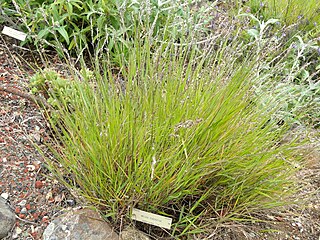Melica argyrea is a species of grass found in Argentina, Brazil, and Uruguay.

Melica amethystina is a grass species in the family Poaceae that can be found in southern Europe.
Melica argentata is a species of grass endemic to Chile.
Melica animarum is a species of grass that is endemic to Sierra de las Ánimas in Uruguay.
Melica longiflora is a grass species in the family Poaceae that is endemic to Chile where it can be found from Coquimbo to Talca.
Melica bonariensis is a species of grass endemic to Argentina where it can be found in such provinces as Buenos Aires, La Pampa, and Rio Negro.

Melica violacea, is a species of grass in the family Poaceae endemic to Chile.

Melica teneriffae, is a grass species in the family Poaceae that is endemic to the Canary Islands.
Melica spartinoides, is a species of grass in the family Poaceae that is endemic to the Brazilian state of Santa Catarina.
Melica serrana, is a species of grass endemic to Cerro de las Ánimas, Uruguay.
Melica hyalina is a species of grass found in Brazil and southern South America.
Melica glabrescens is a species of grass found in Buenos Aires and Río Negro, Argentina.
Melica decipiens is a species of grass that can be found in the mountains of Cordoba and San Luis provinces of Argentina.
Melica hunzikeri is a species of grass that is endemic to southern South America.
Melica minor is a species of grass in the family Poaceae. It is endemic to Caucasus.
Melica paulsenii is a species of grass endemic to Chile where it grows along the coastal cordillera at 50–700 metres (160–2,300 ft) above sea level.
Melica mollis is a species of grass endemic to Chile where it grows in rock crevices at 340 metres (1,120 ft) above sea level.
Melica patagonica is a species of grass that is endemic to South America.
Melica parodiana is a species of grass found in Buenos Aires, Argentina and Uruguay.
Melica riograndensis is a species of grass in the family Poaceae that is endemic to Brazil.


